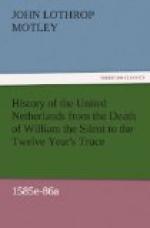The opening thus successfully made, and the envoy having thus, “by many insinuations,” prepared her to lend him a “more patient and willing ear than she had vouchsafed before,” he again entered into a skilful and impassioned argument to show the entire wisdom of the course pursued by the Earl.
It is unnecessary to repeat the conversation. Since to say that no man could have more eloquently and faithfully supported an absent friend under difficulties than Davison now defended the Earl. The line of argument is already familiar to the reader, and, in truth, the Queen had nothing to reply, save to insist upon the governor’s delinquency in maintaining so long and inexplicable a silence. And—at this thought, in spite of the envoy’s eloquence, she went off again in a paroxysm of anger, abusing the Earl, and deeply censuring Davison for his “peremptory and partial dealing.”
“I had conceived a better opinion of you,” she said, “and I had intended more good to you than I now find you worthy of.”
“I humbly thank your Highness,” replied the ambassador, “but I take yourself to witness that I have never affected or sought any such grace at your hands. And if your Majesty persists in the dangerous course on which you are now entering, I only pray your leave, in recompense for all my travails, to retire myself home, where I may spend the rest of my life in praying for you, whom Salvation itself is not able to save, if these purposes are continued. Henceforth, Madam, he is to be deemed happiest who is least interested in the public service.”
And so ended the second day’s debate. The next day the Lord-Treasurer, who, according to Davison, employed himself diligently—as did also Walsingham and Hatton—in dissuading the Queen from the violent measures which she had resolved upon, effected so much of a change as to procure the insertion of those qualifying clauses in Heneage’s instructions which had been previously disallowed. The open and public disgrace of the Earl, which was to have been peremptorily demanded, was now to be deferred, if such a measure seemed detrimental to the public service. Her Majesty, however, protested herself as deeply offended as ever, although she had consented to address a brief, somewhat mysterious, but benignant letter of compliment to the States.
Soon after this Davison retired for a few days from the court, having previously written to the Earl that “the heat of her Majesty’s offence to his Lordship was abating every day somewhat, and that she was disposed both to hear and to speak more temperately of him.”
He implored him accordingly to a “more diligent entertaining of her by wise letters and messages, wherein his slackness hitherto appeared to have bred a great part of this unkindness.” He observed also that the “traffic of peace was still going on underhand; but whether to use it as a second string to our bow, if the first should fail, or of any settled inclination thereunto, he could not affirm.”




